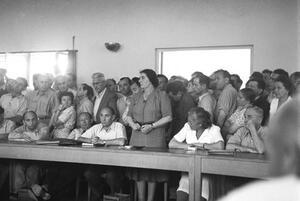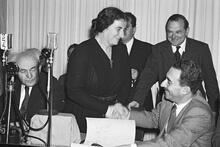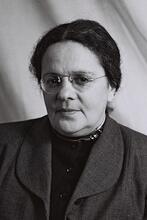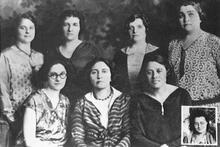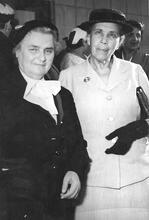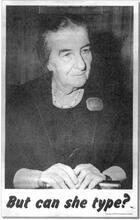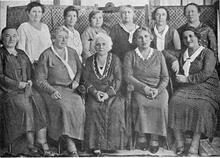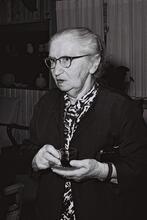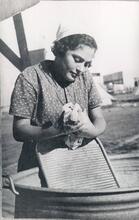Histadrut
Photograph by Zoltan Kluger, courtesy of Israel Government Press Office.
The Histadrut was an important force in the consolidation of economic activity among Jewish inhabitants of pre-state Palestine, but it was not a particularly progressive force for gender equality. While conceptually the Histadrut subscribed to the notion that women should enjoy equal rights, both Histadrut and non-Histadrut women, when they worked at all, were subject to wage discrimination, received inferior jobs, and were grossly under-represented in the various organizations of the Histadrut, their chances of achieving executive positions slim. Activists including Ada Maimon formed a women’s branch within Histadrut called Mo’ezet ha-Po’alot (Council of Women Workers) to advocate their interests, though setting women’s issues aside allowed women to rise in the Histadrut’s ranks, as future Israeli Prime Minister Golda Meir did.
In 1920, with the beginning of the Mandate for Palestine given to Great Britain by the League of Nations in April 1920 to administer Palestine and establish a national home for the Jewish people. It was terminated with the establishment of the State of Israel on May 14, 1948.British Mandate following World War I, a new workers’ organization, Histadrut ha-Ovdim ha-Clalit (the General Federation of Workers), was formed by the Jewish workers who immigrated to Mandatory Palestine. The Histadrut comprised men and women workers, both wage-earners and homemaker wives of Histadrut members. The Histadrut did not restrict its spectrum of activity, nor did it limit its scope of membership. Indeed, its charter declared that every working man and woman over the age of eighteen who lived by his or her own earnings and concurred with the policies of the Histadrut was eligible for membership.
Though it was primarily oriented towards city workers, inhabitants of the communal A voluntary collective community, mainly agricultural, in which there is no private wealth and which is responsible for all the needs of its members and their families.kibbutzim and other semi-collective settlements (moshavim) also became members of the Histadrut. Members of the non-collective agricultural colonies (Lit. "village." The dominant pioneer settlement type of the Jews in Palestine between 1882moshavot) were accepted on an individual basis. Since the urban sector was the largest sector of the Jewish community in Palestine prior to the establishment of the State of Israel. "Old Yishuv" refers to the Jewish community prior to 1882; "New Yishuv" to that following 1882.Yishuv, male and female city workers constituted the majority of the Histadrut.
The Histadrut was the pivot of the Jewish Labor Movement in mandatory Palestine and its creation was key to the development of the Zionist Labor Movement. Its founders, who had been trying to organize for over a decade, sought ways to unite all Jewish workers and thus decided to generate as wide a definition of the organization as possible. The Histadrut could be defined as trade union and cooperative organization combined. All trades, professions, and occupations could be represented in it, provided that all workers enjoyed the fruits of their own toil and not those gained by employing others.
The inclusive nature of the Histadrut had a distinct purpose—to enlist the support of Jewish immigrants who chose mandatory Palestine as their destination. (It should be noted that this came at the expense of Palestinian workers, who were excluded from the Histadrut, at least until 1948.) In return, the Histadrut strove to grant its members assistance in all aspects of life: economic, physical, through health care, and intellectual, through education and other welfare institutions.
Myth and Reality: Women’s Place in the Histadrut
The Zionist national project and its revolutionary entity, the Labor Movement, indeed granted women an honorable place in the creation of a Jewish nation. However, with respect to the “woman question,” Zionist-Socialist thinking was ambivalent at best; while conceptually the Histadrut subscribed to the notion that women should enjoy equal rights, the reality was vastly different. Histadrut and non-Histadrut women alike were subject to wage discrimination, received inferior jobs, and were grossly under-represented in the various organizations of the Histadrut. Thus their chances of achieving managerial positions were slim.
Married women were no exception; whether or not they participated in the labor force, they had difficulty breaking out of their traditional roles. Women were the facilitators of everyday family life; they were the caretakers of their husbands, children, and next of kin. Living on their husbands’ meager salaries, housewives had to be industrious, creative and frugal. Married women, many of whom were recent immigrants, had to transform swiftly into knowledgeable local housekeepers and needed to remain so in the fairly good times as well as in the cycles of economic turmoil that plagued the Yishuv economy. Hence the decisions family women made and the responsibilities they assumed were key to the well-being of the entire family. Yet in the “community of workers” which leaders of the Histadrut aspired to create, men workers, and not women workers or workers’ wives, were the center of organizational efforts and assistance. The primary role of Histadrut women remained mainly to fulfill their family’s needs in the realm of their private homes. Since the Histadrut could not provide all men’s needs, women’s collaboration and willingness to perform wifely duties were essential.
Modes of Membership
Women joined the Histadrut in one of two ways: voluntarily or automatically. Only a minority of women joined the Histadrut as the result of an ideological decision. Usually, joining the Histadrut resulted from an urgent need to get a job in or through the various Histadrut organizations, which required membership. Frequently, this form of membership did not last long; as soon as women got the job, or when they were dismissed, their membership was cancelled. The vast majority of women were either recruited or annexed to the Histadrut involuntarily. This automatic form of participation occurred when one or more workshops, factories or other industrial plants decided to join the Histadrut collectively, as one unit, including both men and women workers. This format of membership brought the Histadrut most of its female wage earners. Similarly, the kibbutzim and moshavim joined the Histadrut on a collective basis, which also included men and women. The largest category of automatic annexation was that of wives of Histadrut members, who were annexed to the Histadrut merely by virtue of their marital status. Consequently, in pre-state Israel at any given time, data indicate that wives of Histadrut members composed the bulk of Histadrut women:
Involuntary and automatic membership thus spawned women’s low status in the Histadrut. The arbitrary termination of membership, a policy implemented by the leadership of the Histadrut in order to gain greater control, epitomized Histadrut women’s inequality and subordination. Since workers’ wives became members of the Histadrut alongside their husbands, they were more likely to be ousted when their husbands were banned from membership.
Married women were often unilaterally expelled from the Histadrut, primarily when their husbands were accused of “exploitation,” meaning that they hired employees and thus were transformed into employers—those who, in the view of the Histadrut, take advantage of others. Cases of husbands being expelled from the Histadrut as a result of their wife’s exploitation, however, were rare. Compulsory dismissal was worse for married women who enjoyed independent membership based upon their working status, and this indeed proved women’s marginality in the Histadrut. It is important to note that not only working women’s interests were at stake, but those of the trade unions, since the latter needed every worker they could recruit in order to fortify their own frail status within the Histadrut.
Women who joined the Histadrut became members of a special “women’s department.” The Mo’ezet ha-Po’alot (the Council of Women Workers) was the elected apparatus of Histadrut women, which was subordinate to the Va’ad ha-Po’el (the executive committee of the Histadrut). During the late 1920s and the 1930s a few organizational and structural changes occurred within Mo’ezet ha-Po’alot. These changes reflected the priorities and currents prevailing in the Histadrut, one of which was the formation in 1934 of a new women’s body: Irgun Imahot Ovedot Be-Meshek Beitan (The Homemakers’ Organization). In 1976 the Histadrut women’s apparatus changed its name to Na’amat, the Movement of Working Women and Volunteers, which currently has 300,000 members in Israel and nine branches around the world with 20,000 members.
The Mo’ezet ha-Po’alot was confronted with an inherent contradiction that had ramifications for both its activists and members. On the one hand, being the elected apparatus of working women, its activists had to protect the interests of women wage earners, married or not. On the other hand, leaders of Mo’ezet ha-Po’alot had to meet the requirements of the vast majority of Histadrut women, stay-at-home mothers with families, who did not officially participate in the labor force.
As a result, leaders of the Mo’ezet ha-Po’alot denounced the automatic association of husband and wife. Such association, they asserted, resulted in referring to a married couple as one inseparable economic unit. Apart from the obvious harm to women’s economic status and image, the policy of automatic association had another flaw: the status of the Mo’ezet ha-Po’alot within the Histadrut declined, along with its control over Histadrut women.
To resolve this dilemma, activists of the Mo’ezet ha-Po’alot strove to create a new independent and voluntary form of membership for wives of Histadrut members. In juxtaposition with the Histadrut’s goal of attaining hegemony in the Zionist Movement and the Yishuv, women activists campaigned for the purchase of “independent” membership cards. Data confirm that following the beginning of the campaign in 1937, 67.2 percent of all Histadrut women had membership cards. In 1940 in Tel Aviv alone 70 percent of Histadrut women had them. However, although women purchased membership cards, these did not grant them substantial privileges. In fact, the whole campaign once again illustrated the subordination of Histadrut women and their dependency on male authority. Since the husbands’ consent to purchase the cards for their wives, or to provide them with the means to do so, was vital, women’s “independent” status remained mostly declarative.
Histadrut Women and the Trade Unions
According to the Histadrut’s charter, composed in 1923 at its second general convention, all Histadrut members regardless of their sex had to become members of trade unions. However, this policy of compulsory membership was often overlooked by Histadrut members, who did not abide by the rule and did not officially become members of any trade union. Histadrut trade unions were open to all workers based on industrial principles and not on professional ones, and they did not ban working women from membership as such. Despite the equal declaration of membership, women were generally discriminated against. Subjected to the Zionist-socialist hegemony, urban working women were also regarded as inferior to women in the agricultural collective and non-collective centers. Working women in general were expected to set aside any demands for changes in their status and to postpone their struggle for equality. Forced to give gender priorities lower consideration if any, Histadrut women were doubly restricted: on the one hand they had to pave their way into the trade unions regardless of their gender, and on the other hand they had to become members of a special gender-based “women’s department,” the Mo’ezet ha-Po’alot.
In the economic realm of pre-state Israel and for years to come, Histadrut and non-Histadrut wage-earning women faced occupational segregation, substantial income differentials and dire working conditions. As in other developing countries, the division of labor positioned women in a limited number of economic branches, usually at the lowest end of the scale: Women laborers were concentrated in mixed agriculture, in a few branches of industry—mainly needlework and textiles—and in domestic service. In a handful of occupations in the public and social services, such as typists, kindergarten teachers and nurses, women constituted the majority. According to data provided by the Histadrut, in 1937 60 percent of workers in the fields of health and education were women, 67 percent of whom were nurses, while only thirteen percent of the women in health care were doctors. Comparable distribution is found in education. 97 percent of all kindergarten teachers were women, whereas men constituted 61 percent of schoolteachers. In agriculture, women comprised 33.8 percent of the labor force; 42 percent of all workers in vegetable growing were women, 70.5 percent in nurseries, and 71 percent in poultry tending. In industry, gender-based segregation was also pronounced: 50 percent of textile workers were women, and in clothing production 64 percent were women. Still fewer women were employed in the emerging new industries. In 1943, data provided by the Jewish Agency indicated that twenty percent of women workers were employed in the chemical industry, fifteen percent in leather, eleven percent in diamonds, ten percent in metal work, but only one percent in machinery operation. As these statistics suggest, women laborers were concentrated mainly in seasonal, non-technical, low paying jobs.
Of all occupations, domestic service most blatantly proved Histadrut women’s marginality. This was almost exclusively a female occupation and in bad economic times, such as the depression of the mid-1930s, women flocked to it. In Tel Aviv in 1937, more than 23 percent of all women wage earners were domestic workers, but only a few were Histadrut members. Organizing domestic work was therefore a challenge to women activists, primarily in the local branches of the Histadrut. Women organizers needed the support of the Histadrut’s male-dominated apparatus, both locally and nation-wide. As a result of this dependency, and since their male counterparts were willing to assist only half-heartedly, the women activists were caught in a complex situation. They could not avoid seeing the plight of the women workers, whereas men activists had a different agenda in mind: they wanted to make sure that the new trade union was kept under their control and would serve only as means to recruit new (female) members to the Histadrut. A strong and well-organized female trade union could put men’s ambitions at risk.
Yossef Kitzis, a key player in Tel Aviv’s Mo’ezet Ha-Po’alot, the local workers’ council, argued that all women’s independent organizations should be banned. The new female initiative was no exception. However, since the pressure from rank-and-file women to act on their behalf was immense, the Mo’ezet Ha-Po’alot agreed to form the new trade union in 1928 on condition that such a trade union would enlist only new women workers to the Histadrut. As soon as the newly recruited women became members of the Histadrut, they had to be supervised by the Mo’ezet Ha-Po’alot.
Following its establishment, the union’s efforts to regulate domestic work were impaired by the rigid administration of the Histadrut. Lacking any substantial financial or organizational resources, the new domestic-work trade union was incapable of controlling domestic workers or significantly influencing their employers. Although a new domestic-work employment bureau was founded in 1931, rivalries between members of the Communist party and Mapai, the leading party of the Histadrut, as well as rigorous competition on the part of non-Histadrut agencies, followed by a price war, paralyzed the new organization.
Dire economic conditions and the critical need to consolidate the competition between human resource agencies forced all parties to reconsider their policies. Thus, in 1938, the new female-only trade union in the Histadrut was recuperating, and in 1939 it finally managed to reach an agreement with the various employment agencies aimed at solidifying working conditions and wages in the field. Just before World War II, the domestic-work trade union was transformed into a middle size trade union, which in Tel Aviv comprised only three to four percent of all workers. It was a feeble union, since its members constituted a weak sector of the work force. Activists of the newly recuperating trade union promoted reduction of membership fees for domestic workers, administered minimum wages with some authority, and mitigated conflicts between employers and employees. By insisting upon hiring only Histadrut domestic workers, activists aimed at inculcating class and gender consciousness in uncaring Histadrut members, who however rarely abided by this rule.
As the meandering case of unionizing domestic workers proves, women’s experience with trade unions was ambiguous. Trade union activists everywhere responded to women with ambivalence and suspicion, if not outright hostility. They considered working women less competent than their male counterparts, and as they were regarded as temporary workers—usually until marriage—male activists were not eager to organize female members.
Trade union leaders did not protect women members from the Histadrut’s discriminative policies. Working women were, and still are, subject to gender-based rates, lower than those of their male counterparts. According to data provided by the Histadrut, the minimum wage for a man working in industry in the mid-1930s was twenty Erez-Israel grush (grush = 10 mils; 1,000 mils = one Palestine pound) per day, as distinct from twelve grush or less per day for a woman. The wage gap still prevails; in 2000 the average monthly salary for women was NIS 5,015 as compared with NIS 8,147 for men, and in 2018 the median monthly gross income for women was NIS 6,782 and for men NIS 9,207.
Histadrut Women in Leading Positions
Women were less likely than men to achieve high-ranking positions in the unions or in the Histadrut and were less likely to enjoy the protection they needed in the workplace. At present, with more women in the labor force, there is some improvement in women’s representation in the trade unions and in local branches of the Histadrut. Women’s current modest representation in the Histadrut is indicated by the fact that four trade unions—of healthcare workers, social workers, academics in the social sciences and humanities, and biochemists and microbiologists respectively—are headed by chairwomen.
Despite these difficulties, in the 1920s and 1930s trade union women sometimes managed to attain leading positions and express self-determination. In branches traditionally worked by women such as the textile industry, women maintained key positions in the trade unions and led strikes that forced employers and Histadrut representatives to consider their demands. Yet in the long run these successes did not yield any fundamental change in Histadrut women’s status. The mainstream leadership of both men and women were reluctant to promote workers’ militancy and independence. Consequently, urban women’s interests were neglected and their status in the work place and in the Histadrut remained inferior.
Women’s representation in leading positions in the Histadrut had and still has pronounced gender characteristics. Women were poorly represented in central level committees and organizations of the Histadrut nationwide as well as locally. Few participated in both women’s and men’s apparatus, and then usually in areas connected to women’s traditional domain—welfare, education, and health—and in the specific departments of Histadrut women. A few women rejected any separate women’s agenda and therefore participated in the general forums only.
From the pre-state era to date, not a single woman has been nominated as secretary of the Histadrut and only a handful of Histadrut women have headed local workers’ committees or other major divisions. Women were more likely to be represented in the secondary tier of the Histadrut’s apparatus. Women participated in the legal forum (Mishpat Haverim), in the welfare apparatus (Mish’an), in various economic companies such as Nahshon (the Histadrut’s pre-state shipping company), and several others. This remained the case decades after the State of Israel was founded. In 1983, following the reorganization of the Histadrut a few years earlier, out of 45 members of Ha-Va’adah ha-Merakezet (the coordinating committee) seven were women; eight women out of a total of 62 members held positions in the Trade Union Division, all of them in the traditional and most prevalent female occupations. Six of the women served as the secretaries of the various unions of textile workers, nurses, physiotherapists, occupational therapists, paramedical occupations and hygienists, and social workers. At present, six women—besides Na’amat’s chairwoman—participate in the Histadrut’s central executive of approximately 30 persons. The Histadrut is now facing another reform, which will yield further changes in the representation of both men and women.
These patterns of women’s participation were replicated in the local arena as well. Women were represented in the workers’ councils, Mo’azet ha-Po’alot, in a separate women’s department and in various secondary positions. In 1937 women composed 34 percent of all workers in Tel Aviv (17,128 men and 5,841 women; workers’ wives were not included). Yet of the 54 members of the workers’ council, only seven, a mere 12.9 percent, were women. (Workers’ wives were approximately eleven thousand, which decreased the rate of women’s representation even further.) This state of affairs did not change significantly later in the decade. In 1939 only eight women served on the various committees of the Tel Aviv Mo’ezet ha-Po’alot and most of them had a role in the female sector. Not a single woman held a senior position, such as secretary of the Council. This remained the case for decades to come; in 1983, in each of the 72 Mo’azet ha-Po’alot branches in the country, only men held the top position of secretary. The situation has changed only marginally: in 2004 only one out of approximately 30 chairpersons of local workers’ committees (Mo’ezet Po’alot Merhavit) was a woman.
Only a handful of persistent and loyal women were able to some degree to escape gender barriers and become members of the selective Va’ad ha-Po’el (executive committee of the Histadrut). One of them was Golda Meir (Myerson), who was elected to office in 1930 and who for a short period of time was also a secretary in the Mo’ezet Ha-Po’alot. Later in the decade, she served in the most exclusive forum of the Histadrut, the secretariat, although she was not officially elected. Throughout the 1940s Meir was chairwoman of Ha-Va’ad ha-Mefakeah (the supervisory committee) of the Clalit Health Fund (the Histadrut’s health clinics) and became the key figure of all Histadrut welfare organizations.
Meir was well connected to the Histadrut’s elite and maintained a close relationship with many of its members. She can therefore be classified as a woman activist who was chosen by male patrons to become their protégée. When opportunities arose, she was asked to serve on key committees. Acknowledged by her patrons as loyal and reliable, Golda Meir was promoted to top positions. During the pre-state era, she headed the political department of the Histadrut in the early 1940s, and later in the decade she headed the political department of the Jewish Agency. Following the foundation of the State of Israel, Golda Meir served in other key positions, including minister of labor. In 1969 she became the Prime Minister of Israel.
A different model of a woman activist was represented by Rosa “the Red” Cohen (1890–1937). Rosa Cohen was born in the Russian Empire. Her father objected to her studying at a Russian high school, but she decided to go to work and earn her high-school diploma. During the 1905 pogroms, at the young age of fifteen, she participated in a Jewish self-defense organization. She soon became involved in radical circles and was active among the Russian poor. In World War I she worked as a bookkeeper in one of the military factories, where her socialist point of view was cemented. As a result, she decided to distribute her earnings among the needy, a practice she maintained later in her life as well. Like many of her cohorts, she was disillusioned by the Bolshevik Revolution, and though she was not a Zionist she decided to immigrate to Palestine in 1919.
In more than one way Rosa Cohen-Rabin can be identified as a self-nominated activist. Following the outbreak of violence in Jerusalem in 1920 she—together with a few men—volunteered to organize self-defense among the Jews of the Old City. Soon afterwards she and her newlywed husband, Nehemiah Rubitzov (1889?–1972), moved to Haifa, where she returned to her previous occupation and became a bookkeeper in her relatives’ factory. When another wave of violence broke out in 1921, she organized self-defense among the Jews of Haifa. In 1923 the young family moved to Tel Aviv, where she lived till her untimely death.
In Tel Aviv the presence of “Red Rosa” was highly pronounced. She was active in the broad Histadrut arena, from welfare to health and education. A member of the municipal council of Tel Aviv and of the local workers’ council, she also participated in numerous committees and organizations, but not in the all-female one. Rosa Cohen did not believe in the concept of a separate women’s agenda, and though she was sympathetic to women’s problems she refused to take part in any gender-based activity.
In contrast to both Golda Meir and Cohen, Ada Maimon (Fishman) was a true feminist. As soon as the Histadrut was founded in 1920, Maimon immersed herself in its activities, serving as a member in the executive committee (Ha-Va’ad ha-Poel) in the early 1920s, as well as in a number of other committees and departments.
Of the many public duties Maimon fulfilled throughout her life, founding a distinct movement for women workers was her hallmark. In a protest against denying women workers their own representation in the Histadrut, Maimon forced the newly-elected leadership to acknowledge the new organization of women workers she helped create, Mo’ezet Ha-Po’alot, and to grant women an independent-yet-affiliated status within the Histadrut. Maimon served in the secretariat of the Mo’ezet Ha-Po’alot and designed most of its policies. One of them was forming a partnership in the late 1920s with WIZO, the organization of middle-class Zionist women, despite antagonism from rivals within the movement, including Golda Meir. From 1932, when Ayanot, the new agricultural farm for women which she initiated, began to operate, her dominant position in the secretariat declined as another key player, Beba Idelson, rose to power.
Conclusion
Although accepted to the Histadrut on an equal basis, Histadrut women were subject to discrimination in every form of activity, from labor to management and politics. Nevertheless, women chose to collaborate with the Histadrut’s leadership. Indeed, Golda Meir’s meteoric rise to top positions proved this choice to be beneficial for the few women who put women’s unique issues and interests aside and instead furthered a “general” i.e. Zionist-socialist agenda. This is still the case. Data prove that Histadrut women today prevail in a “women’s niche”—Na’amat—where they can be better represented. In the “general” arena, however, Histadrut women still have a long way to go to achieve equality.
Books
Avizohar, Meir. Bi-rei saduk: idealism hevratiyim u-leumiyim ve-hishtakfutam be-‘olamah shel Mapai (National and Social Ideals as Reflected in Mapai, The Israeli Labour Party, 1930–1942). Tel Aviv: Am ‘oved, 1990.
Bartal, Gavriel. Ha-Histadrut ha-kelalit—mivneh u-fe ’ulto (The General Workers’ Federation: Structure and Activities). Tel Aviv: ha-Histadrut ha-kelalit shel ha- ‘ovdim be-Erets Yisrael, 1985.
Bernstein, Deborah S. Constructing Boundaries: Jewish and Arab Workers in Mandatory Palestine. Albany: State University of New York Press, 2000.
Bernstein, Deborah S. “Human Being or Housewife? The Status of Women in the Jewish Working-Class Family in Palestine of the 1920s and 1930s.” In Pioneers and Homemakers: Jewish Women in Pre-state Israel, edited by Deborah S. Bernstein, 235-259. Albany: State University of New York Press, 1992.
Bernstein, Deborah S. “The Plough Woman Who Cried into the Pots: The Position of Women in the Labor Force in Pre-State Israeli Society.” Jewish Social Studies 45, no. 1 (1983): 43–56.
Bernstein, Deborah S. The Struggle for Equality: Urban Women Workers in Prestate Israeli Society. New York: Praeger, 1986.
Elboim, Rachel Dror. “Women in Zionist Utopianism” (Hebrew). Cathedra 66 (1992): 111–143.
Hyman, Paula. “Labor Organizing and Female Institution.” In Women, Work, and Protest, edited by Ruth M. Milkman, 22–41. Boston: Routledge & Kegan Paul, 1985.
Izraeli, Dafna., and Kalman Gaier. “Sex and Interoccupational Wage Differences in Israel.” Industrial Relations 18, no. 2 (1979): 227–232.
Kafkafi, Eyal. “The Psycho-Intellectual Aspect of Gender Inequality in Israel’s Labor Movement.” Israel Studies 4, no. 1 (1999): 188–211.
Katznelson-Shazar, Rahel. Adam kemo she-hu: prike yomanim u-reshimot (The Person as She Was). Tel Aviv: Am ‘oved, 1989.
Kessler, Alice Harris. “Problems of Coalition-Building: Women and Trade Unions in the 1920s.” In Women, Work, and Protest, edited by Ruth M. Milkman, 110–131. Boston: Routledge & Kegan Paul, 1985.
Kolat, Israel. “The Concept of the Histadrut: Emergence and Change (1920–1948).” In Labor and Society in Israel, edited by Isaiah Avrech and Dan Giladi, 204–227. Tel Aviv: Department of Labor Studies, Tel Aviv University, 1973.
Maimon, Ada Fishman. Hamishim shenot tenu’at ha-po ‘alot, 1904-1954 (Fifty Years of the Women Workers’ Movement, 1904–1954). Tel Aviv: Ayanot, 1955.
Milkman, Ruth. “Organizing the Sexual Division of Labor: Historic Perspectives On ‘Women’s Work and the American Labor Movement.’” Social Review 10 (1980): 95–110.
NA’AMAT website. https://naamat.org/.
Porez, Ada. “The Rule of Women’s Representation in the Workers’ Committees” (Hebrew). Master’s thesis, Tel Aviv University, 1980.
Porez, Ada, and Dafna Izraeli. Women and Men in Workers’ Committees in the Industry (Hebrew). Tel Aviv: 1980.
Rabin, Yizhak. My Father’s Home (Hebrew). Hakibbutz Hameuchad, 1970.
Regev, David. “Report on the Status of Women in Israel” (Hebrew). Yedioth Ahronoth, November 10, 2002.
Rozen, Giora. “The Histadrut’s Trade Union in the World War II Era” (Hebrew). Master’s thesis, Tel Aviv University, 1974.
Stern, Bat-Sheva Margalit. “Rebels of Unimportance: The 1930s Textile Strike in Tel Aviv and the Boundaries of Women’s Self-Reliance.” Journal of Middle Eastern Studies 33, no. 3 (2002): 171–194.
Stern, Bat-Sheva Margalit. “Recruiting and Organizing Women in the Histadrut: Establishing the Domestic Workers Trade Union in Tel Aviv: A Case Study” (Hebrew). Yahadut Zemanenu 14 (2001): 185–224.
Stern, Bat-Sheva Margalit. “The Women Workers’ Movement in Pre-State Israel: The Women Workers’ Council, 1920–1939” (Hebrew). Ph.D. diss., Haifa University: 1997.
Sternhell, Zeev. The Founding Myths of Israel: Nationalism, Socialism, and the Making of the Jewish State. Princeton: Princeton University Press, 1998.
Tzahor, Zeev. On the Road to Yishuv Leadership: The Formative Years of the Histadrut (Hebrew). Jerusalem: Yad Ben-Zvi, 1981.

